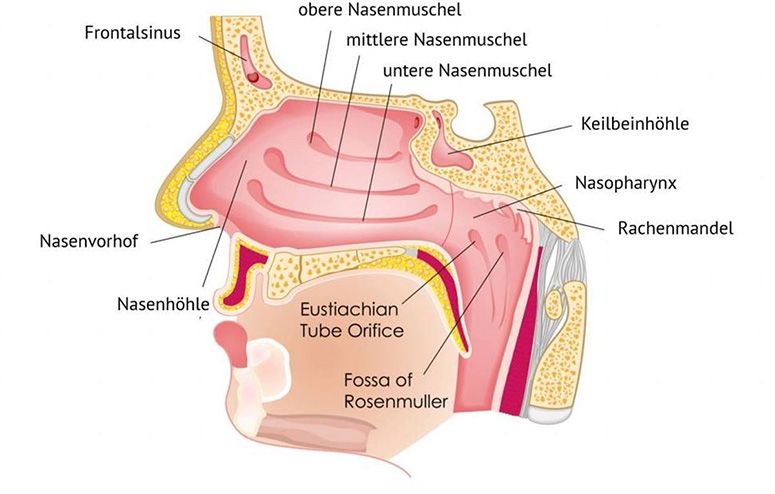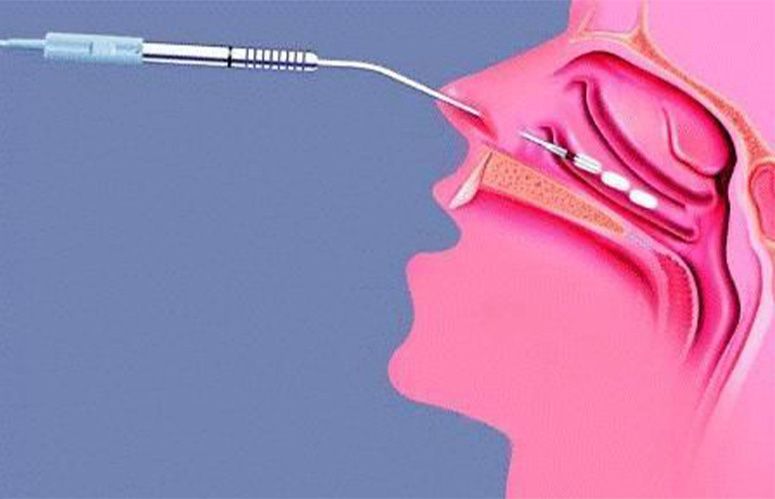- Mon - Thu:
- 08:30 - 12:00, 14:30 - 18:00
- Fri:
- 08:30 - 12:00
- Mon - Tue; Fri:
- 08:30 – 12:00
- Wed:
- 14:30 – 18:00
- Mon - Fri:
- 08:30 – 10:30
(Capacity limited – we ask that you register by telephone)
Nasal concha reduction
Anatomy and physiology of the nasal concha
The nasal concha (Concha nasales) are thin, air-filled fine sheets of bone which are covered by mucous membrane. There are 3 nasal concha structured in pairs: the inferior, middle and superior nasal concha. The nasal concha are located on the side walls in the nasal cavity and divide this into three nasal passages – the superior, middle and inferior nasal passage.
The erectile tissue itself is located underneath the mucous membrane. This tissue contains a dense capillary network, which may be engorged with blood to different levels. If it becomes heavily engorged, the nasal concha swells. If the blood supply is curbed, the swelling of the nasal concha subsides. Similar to adrenaline, for example, if the person is very excited or is exerting themselves, decongestant nasal drops cause the capillary network to be less engorged with blood and the swelling of the nasal concha reduces as a result. The nasal concha are secured by a small bone (os turbinale) in the main nasal cavity.
The inferior nasal concha is particularly significant, as it regulates the air permeability of the nose, which is a basic requirement for the cleaning and conditioning of the air we breathe. If it is significantly enlarged, it can be seen with the naked eye by looking inside the nose with the help of a torch. The middle nasal concha is positioned slightly higher and constitutes the entrance to the paranasal sinus system. The superior nasal concha is home to part of the olfactory cells and can only be detected when the swelling in the nose has gone down or during an operation.
The mucous membrane of the nasal concha humidifies and warms the air we breathe and filters small particles out of it. It additionally regulates the respiratory flow.
If the inferior nasal concha were always completely free from swelling, the air would not be warmed, humidified or filtered during nasal breathing and this could lead to recurrent throat infections. If the nasal concha are too heavily swollen and it is necessary to switch to mouth breathing too quickly, the same problem occurs. The air which is now no longer warmed and humidified also leads to throat infections more frequently or to a chronic sensation of a foreign body in the throat.

Causes of swollen nasal concha
- Allergic reactions (e.g. hay fever)
- acute or chronic rhinitis / sinusitis
- Dependence on decongestant nasal sprays(“Rhinitis medicamentosa”)
- Hormonal changes: A woman’s hormone levels alter during puberty, pregnancy or the change of life (menopause). One result of this shift may be an enlargement of the nasal concha.
- Side effects of medications, e.g. blood pressure reducers or psychotropic drugs
- Tissue growth: Due to an injury, excessively dry living and working areas or a malfunction, the nasal concha tissue may grow excessively, leading to disproportionate growth in the nasal concha.
Surgical treatment of nasal concha hyperplasia
We treat this using radio frequency technology, a modern procedure with modulated, high-frequency thermoablation for the interstitial treatment or shrinkage of sub-mucous tissue. Using an impedance-controlled bipolar electrode which is introduced into the area of the frontal head of the nasal concha parallel to the os turbinale, depending on the state of the tissue, higher or lower radio frequency energy is applied in the inner area of the nasal concha. The procedure is repeated in the middle area of the concha and in the rear third of the nasal concha as necessary. In pronounced hyperplasia of the frontal head of the nasal concha, a second application may be carried out in the subordinate portions of the head of the nasal concha.
The tissue treated in this selective targeted manner is broken down by the body’s own immune system and converted to fibrous scar tissue. This process leads to shrinkage and stiffening of the tissue.
Compared to conventional methods, such as e.g. laser, this procedure offers the advantage that the surface of the nasal concha remains intact and a reduction in volume occurs only internally. The mucous membrane which is responsible for the functioning of the nose is not destroyed. In addition, the procedure may be carried out in the practice on an out-patient basis under local anaesthetic.



